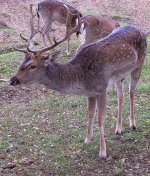 A Fallow Deer (Dama dama) is slender, medium-sized, and its appearance is not exactly ordinary. They are not as stocky as their brethren kind, the legs are quite long, head is thin, and the neck is long, but no...not as long as a giraffe's. A Fallow Deer presents a graceful facade, and it is in fact a parkland creature enjoying popularity. Its coat is quite a sight with its patterns and color. Many Fallow Deers have pale flanks of chestnut brown, while lower areas are white, the same goes for the inside of legs.
A Fallow Deer (Dama dama) is slender, medium-sized, and its appearance is not exactly ordinary. They are not as stocky as their brethren kind, the legs are quite long, head is thin, and the neck is long, but no...not as long as a giraffe's. A Fallow Deer presents a graceful facade, and it is in fact a parkland creature enjoying popularity. Its coat is quite a sight with its patterns and color. Many Fallow Deers have pale flanks of chestnut brown, while lower areas are white, the same goes for the inside of legs.Its tail is long, holds a black end, making it stand out against the rump's white. The male, and they are known as bucks, are bigger and heavier than females. The male Fallow Deer has antlers, which are absent from the distaff side. Indeed, to say that a Fallow Deer's antlers are impressive is not an understatement. Not like other kinds of deer, the Fallow Deer's are flat and broad. Fact is, the antler is dependent on the age of the individual, with of course the old ones holding the largest antlers, fascinating datum huh?
Right after the Ice age (last), these deers were discovered in North Africa, and parts of the Balkans, but due to the heavy hunting of mankind, the numbers quickly went down. Until it came to the point that Asia Minor was the only place where they could be found.
Picture by de:User:APPER, licensed under GFDL
The Fallow deer is listed as Least Concern (LR/lc), lowest risk. Does not qualify for a more at risk category. Widespread and abundant taxa are included in this category, on the IUCN Red List of Threatened Species
Namings for the fallow deer
A young / baby of a fallow deer is called a 'fawn or ass'. The females are called 'doe, hind or cow' and males 'buck, stag or bull'. A fallow deer group is called a 'herd'.Some facts about the
Fallow deer
Adult weight : 70 kg (154 lbs)
Maximum longevity : 21 years
Female maturity :487 days
Male maturity : 507 days
Gestation : 233 days
Weaning : 183 days
Litter size : 1
Litters per year : 1
Interval between litters : 365 days
Weight at birth : 4.5 kg (9.9 lbs)
Weight at weaning : 22.57 kg (49.654 lbs)

Custom Search